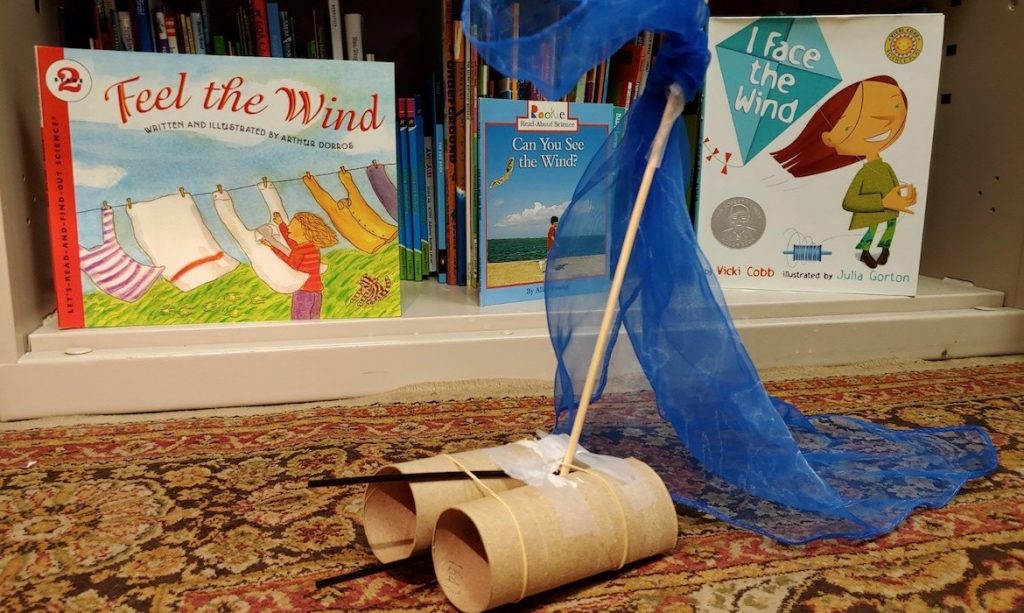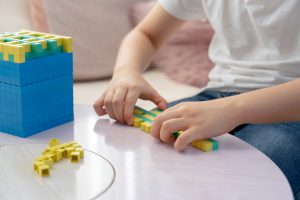- Young children enjoy solving problems and exploring the world through science, technology, engineering, and math (STEM).
- There are fun, easy ways to introduce STEM to preschoolers.
- STEM learning can support children’s early math development and many other important skills.
Science, technology, engineering, and math (STEM) in preschool? You may be thinking, “This is more appropriate for older students, and leads to kids wiggling restlessly at tables in front of worksheets.”
But my experiences exploring STEM with preschoolers suggest otherwise. When engaged in activities that support STEM learning, young children can remain curious, focused, communicative, and active for over 45 minutes (or longer!). What’s more: the children have a blast. And all the while, they are learning STEM concepts and applying math to solve real world problems.
As a teacher educator who prepares prospective and practicing early childhood teachers to teach STEM to preschoolers, I research and develop activities that support young children’s STEM learning. In this blog post, I describe several STEM activities that one of my classes of prospective teachers brought to a preschool—much to the delight of the children. I explain the math learning behind the activities and offer easy suggestions for engaging children around STEM.
Why STEM?
Recent research underlines the importance of early STEM skills and knowledge for children, and the value of supporting educators in early STEM teaching. [1] [2] [3] What young children learn about math and science by the time they enter kindergarten can have an impact on children’s academic outcomes down the road. [4] [5]
In many of the preschool STEM activities that I do with teachers, early math is used to support young children’s understanding of scientific phenomena—such as the wind—and to solve engineering problems. The embedded math concepts and practices are found in many school standards, for both young children and older students. [6] [7]
STEM activities support not only the development of math and science skills, but also provide opportunities to strengthen language skills. [8] Moreover, while each of the four STEM subjects deserves individual attention in school, the subjects are often discussed in terms of how they combine and connect with one another. [9] When paired with another subject, such as language arts, STEM provides an even richer context in which to talk and think about math.
Preschool STEM Activities
How Does the Wind Move Different Objects?
While visiting a preschool classroom, my student teachers and I noticed that the children were naturally curious about the strong winds in their playground. Building on children’s interests is important to early math and science learning. [10] [11] Drawing on this and collaborating with the classroom teachers, we took the children outside to test the force of the wind. We tossed leaves in the air and held up colorful scarves, which served as effective informal tools to measure the wind strength. Children noticed how much the scarves moved and they guessed aloud why.
Back in the classroom, the children tested how far their breath could move a ball across a piece of cove molding. In these experiments, the children built on their understanding of distance and measurement.

How Can We Design Cars and Buildings for Windy Days?
The following week, we brought materials to the classroom to extend the children’s interest in wind and forces. We challenged each child to build a car with sails on it and to see how far the wind from a fan could push the sail cars. [12] We used materials such as scrap paper, plastic bowls, paper plates and cups, craft sticks, straws, paper clips, toilet paper rolls, glue, and tape to construct the sail cars.
We read books about the wind, including “Can You See the Wind?” by Allan Fowler and “I Face the Wind” by Vicki Cobb. Another day, we came back and read, “Dreaming Up: A Celebration of Building” by Christy Hale, and talked about the importance of building structures that can withstand the wind. This gave rise to thinking about physical science concepts, such as stability, strength, and three-dimensional shapes.
Then we gave the children a new engineering challenge to extend their learning: Who can build the tallest structure that will stand up in the wind? We used many of the same materials as in the sail car activity.
In both the sail car and building activity, children planned by drawing on paper, engaged with open-ended materials to create and test structures, and used tools such as tape and scissors. Some worked together in groups while others worked independently.
Children tried to meet engineering challenges, think about how to solve problems in their designs, and make sense of what they had observed. Children’s books about the wind helped to foster the development of both STEM and reading skills.

What About the Math?
Research shows that children learn math concepts deeply when they have multiple, varied opportunities to interact with math, apply what they have learned, and discover math in the real world. During the activities, the preschoolers naturally engaged in conversations and experiments using early math concepts, such as measurement and spatial awareness.
Measurement. In the sail car activity, the children measured how far their cars traveled in the wind. They wrote their names on sticky notes and placed them on the floor to mark and estimate the distance traveled. In the building activity, they used their hands to compare heights of the structures and to keep the bases of the structures on the floor so they could make fair comparisons.
We heard children talk about measurement: Your sticky note is way down the hall—it’s far away. Let’s start our sail cars at the same spot so it’s fair. My structure is taller—look!We also heard children consider weight in their designs: The sail car did not move forward, it only tipped over. A child decided to remove some of the weight to make the sail car lighter (measuring weight informally and without numbers at this stage) and to re-test the vehicle.
The preschoolers recognized that distance and weight are features that can be measured, and they explored the impacts of changing their designs on the measurements.
Spatial awareness. When a child had trouble getting their sail car to work, one of the teachers asked: Does the wind need to be on top of the structure or on the bottom to move it? Once the child decided that it might help if the wind blew toward the bottom of the car, the child was able to figure out what additional materials would provide more surface area lower on the sail car structure.
Children also discussed where to place their sail cars relative to the fan: The air is blowing that way; put it in front of the fan. When a structure fell over, one child reasoned that something bigger was needed at the bottomof the building. A teacher suggested: A wider base?
Learning Life Skills Through STEM
Make sense of problems and persevere in solving them. Children observed, collected data, and solved problems, often making changes to their original designs. For example, in the sail car activity, children said things like: My sail car didn’t move, is it too heavy? His moved and his is lighter. I will take off some of the cups.
When a group of children built a structure that they predicted would withstand a strong wind but instead fell over, they did not fret, cry, or give up. They kept building! They discussed ideas, redesigned the structures, collaborated with their peers and teachers, and tried again. Their thinking about how to fix the designs often involved mathematics (e.g., It’s too heavy). [13]
Reason abstractly and quantitatively. When a sail car didn’t move, one child said, I have too many pipe cleaners, andremoved some of them. Without counting, the child reasoned about quantity and its effect on how cars travel.
Introducing STEM is Easier Than You Think
You may be thinking, “This is great, but I…
- am squeezed for time.
- am not comfortable with math or STEM.
- am not sure how STEM activities fit into my curriculum.”
You are not alone! But all of these challenges can be overcome. Try using a math concept in your classroom that’s new to you, or find a real-world problem that can be explored through engineering. [14] When children’s own ideas actually work (or when their ideas don’t work at first, but children keep trying until they do), it can be transformative—for us and for them.
Through hands-on, minds-on challenges like these, in which children see math as a useful tool, we are on the right track to cultivating a love of math and STEM.
[2] Early STEM Working Group, 2018.
[6] National Association for the Education of Young Children (NAEYC) position statements on early math.
[7] National Association for the Education of Young Children (NAEYC) position statements on early science.
[8] Standards for other grades (e.g., kindergarten standards from Common Core).
[9] Tennessee early childhood education early learning developmental standards for 4-year-olds.
[10] Sarama, Lange, Clements, & Wolfe, 2012.
[11] National Research Council. (2014). STEM Integration in K-12 Education: Status, Prospects, and an Agenda for Research.Washington, DC: The National Academies Press. https://doi.org/10.17226/18612.
[12] Robertson, L., Dunlap, E., Nivens, R., & Barnett, K. (2019). Sailing Into Integration: Planning and implementing integrated 5E learning cycles. Science and Children, 57(1), 61-67.
[13] Mindsets for learning early math.
[14] Mano, H., Molina, K., Lange, A.A., & Nayfeld, I. (2019). Planting the seeds of engineering: Preschoolers think about, talk about, and solve a real problem in the garden. Science and Children. https://www.ecstemlab.com/uploads/4/0/3/5/40359017/plantingtheseeds-ee.pdf



